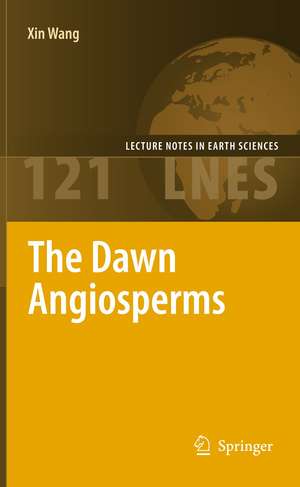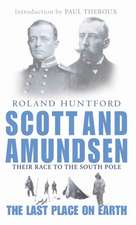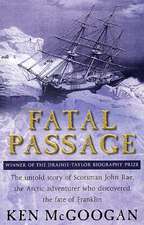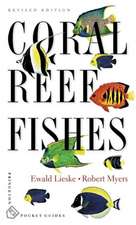The Dawn Angiosperms: Uncovering the Origin of Flowering Plants: Lecture Notes in Earth Sciences, cartea 121
Autor Xin Wangen Limba Engleză Hardback – 3 sep 2010
| Toate formatele și edițiile | Preț | Express |
|---|---|---|
| Paperback (2) | 871.21 lei 38-44 zile | |
| Springer International Publishing – 12 mai 2018 | 952.42 lei 3-5 săpt. | |
| Springer – 4 noi 2012 | 871.21 lei 38-44 zile | |
| Hardback (2) | 777.51 lei 38-44 zile | |
| Springer International Publishing – 14 aug 2017 | 947.28 lei 3-5 săpt. | |
| Springer Berlin, Heidelberg – 3 sep 2010 | 777.51 lei 38-44 zile |
Din seria Lecture Notes in Earth Sciences
- 18%
 Preț: 938.03 lei
Preț: 938.03 lei -
 Preț: 399.43 lei
Preț: 399.43 lei - 15%
 Preț: 636.99 lei
Preț: 636.99 lei - 15%
 Preț: 632.77 lei
Preț: 632.77 lei - 15%
 Preț: 638.61 lei
Preț: 638.61 lei - 15%
 Preț: 640.07 lei
Preț: 640.07 lei - 15%
 Preț: 634.88 lei
Preț: 634.88 lei - 18%
 Preț: 1239.12 lei
Preț: 1239.12 lei - 15%
 Preț: 639.24 lei
Preț: 639.24 lei - 18%
 Preț: 1213.92 lei
Preț: 1213.92 lei - 18%
 Preț: 950.57 lei
Preț: 950.57 lei - 18%
 Preț: 993.81 lei
Preț: 993.81 lei -
 Preț: 381.66 lei
Preț: 381.66 lei - 18%
 Preț: 944.27 lei
Preț: 944.27 lei - 18%
 Preț: 947.42 lei
Preț: 947.42 lei - 15%
 Preț: 632.91 lei
Preț: 632.91 lei - 18%
 Preț: 936.46 lei
Preț: 936.46 lei - 18%
 Preț: 1219.23 lei
Preț: 1219.23 lei - 18%
 Preț: 943.34 lei
Preț: 943.34 lei - 18%
 Preț: 948.21 lei
Preț: 948.21 lei -
 Preț: 394.68 lei
Preț: 394.68 lei - 18%
 Preț: 939.58 lei
Preț: 939.58 lei - 23%
 Preț: 871.21 lei
Preț: 871.21 lei - 18%
 Preț: 998.33 lei
Preț: 998.33 lei - 15%
 Preț: 631.12 lei
Preț: 631.12 lei - 18%
 Preț: 936.13 lei
Preț: 936.13 lei - 18%
 Preț: 939.44 lei
Preț: 939.44 lei -
 Preț: 379.76 lei
Preț: 379.76 lei - 18%
 Preț: 950.57 lei
Preț: 950.57 lei
Preț: 777.51 lei
Preț vechi: 1009.75 lei
-23% Nou
Puncte Express: 1166
Preț estimativ în valută:
148.87€ • 152.71$ • 125.34£
148.87€ • 152.71$ • 125.34£
Carte tipărită la comandă
Livrare economică 22-28 februarie
Preluare comenzi: 021 569.72.76
Specificații
ISBN-13: 9783642011603
ISBN-10: 3642011608
Pagini: 260
Ilustrații: XXII, 238 p.
Dimensiuni: 155 x 235 x 22 mm
Greutate: 0.5 kg
Ediția:2010
Editura: Springer Berlin, Heidelberg
Colecția Springer
Seria Lecture Notes in Earth Sciences
Locul publicării:Berlin, Heidelberg, Germany
ISBN-10: 3642011608
Pagini: 260
Ilustrații: XXII, 238 p.
Dimensiuni: 155 x 235 x 22 mm
Greutate: 0.5 kg
Ediția:2010
Editura: Springer Berlin, Heidelberg
Colecția Springer
Seria Lecture Notes in Earth Sciences
Locul publicării:Berlin, Heidelberg, Germany
Public țintă
ResearchCuprins
Suggested Angiosperm Ancestors.- Angiosperms: Characters and Criteria.- Background for the Plant Fossils.- Flowers from the Early Cretaceous.- Flower-Related Fossils from the Jurassic.- Trace of Possible Angiosperms in the Jurassic.- Making of the Flower.- General Conclusions.
Textul de pe ultima copertă
This book, besides providing necessary background information and discussions, focuses on the earliest angiosperms: namely those more than 125 million years old. Currently 125 million year old angiosperms, are the oldest to be found - especially in the eyes of European scholars. It proceeds by introducing several interesting angiosperms from the Jurassic and early Cretaceous, including Schmeissneria (early-middle Jurassic, 160-199 million years old (Ma)), Xingxueanthus (middle Jurassic, 160 Ma), Solaranthus (middle Jurassic, 164 Ma), Callianthus (early Cretaceous, 125 Ma), Chaoyangia (early Cretaceous, 125 Ma), Archaefructus (early Cretaceous, 125 Ma), Sinocarpus (early Cretaceous, 125 Ma). Others are currently being processed. These fossils, most of which have hitherto not been published,will uncover many unknown aspects of early angiosperms, and help to solve the mystery surrounding their origin.
Caracteristici
Unique work about fossil plants Provides detailed description of pre-historic angiosperms Will trigger many new ideas for research in this field Includes supplementary material: sn.pub/extras
Descriere
Descriere de la o altă ediție sau format:
Angiosperms are the most diversi ed plant group in the world, being represented by ca 300,000 species in about 400 families. Like all of Life, including ourselves, they have had their own history and gone through many evolutionary stages before they arrived at their current forms. The origin of Angiospermae ( owering plants) has been the subject of much dispute because this is a key event in the history of life, and has a far-reaching in uence on our understanding of relationships among seed plants as a whole as well as within the angiosperms. Until recently most of palae- otanists recognized angiosperms only from the Cretaceous and younger strata. This contradicts the results of molecular analyses. I have been working on Mesozoic fossil plants for the past two decades, during which time I have studied a number of fossil plants. Some of these fossil plants have been published as Jurassic angiosperms, and, unsurprisingly, many questions and doubts have been raised about them. These questions need to be addressed se- ously and journal papers do not provide suf cient space to compare and relate these early angiosperms. In this book these pioneer angiosperms are documented in detail, sometimes with new specimens not studied before. Also, I propose a de nition of angiosperms that could be adopted in palaeobotany. My aim is to improve clarity and objectivity of judgment about what constitutes a fossil angiosperm.
Angiosperms are the most diversi ed plant group in the world, being represented by ca 300,000 species in about 400 families. Like all of Life, including ourselves, they have had their own history and gone through many evolutionary stages before they arrived at their current forms. The origin of Angiospermae ( owering plants) has been the subject of much dispute because this is a key event in the history of life, and has a far-reaching in uence on our understanding of relationships among seed plants as a whole as well as within the angiosperms. Until recently most of palae- otanists recognized angiosperms only from the Cretaceous and younger strata. This contradicts the results of molecular analyses. I have been working on Mesozoic fossil plants for the past two decades, during which time I have studied a number of fossil plants. Some of these fossil plants have been published as Jurassic angiosperms, and, unsurprisingly, many questions and doubts have been raised about them. These questions need to be addressed se- ously and journal papers do not provide suf cient space to compare and relate these early angiosperms. In this book these pioneer angiosperms are documented in detail, sometimes with new specimens not studied before. Also, I propose a de nition of angiosperms that could be adopted in palaeobotany. My aim is to improve clarity and objectivity of judgment about what constitutes a fossil angiosperm.










